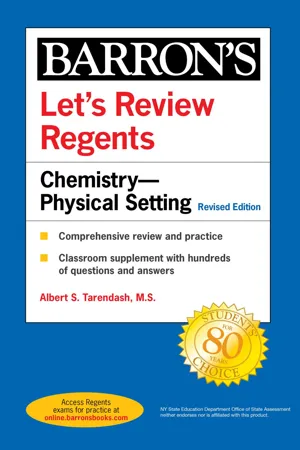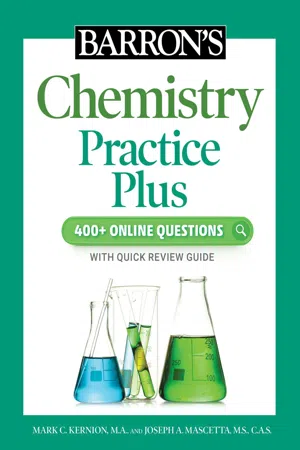Physics
Structure of Periodic Table
The periodic table is a tabular arrangement of chemical elements, organized by their atomic number, electron configuration, and recurring chemical properties. It is divided into groups (columns) and periods (rows), with elements in the same group sharing similar chemical properties due to their similar electron configurations. The structure of the periodic table provides a systematic way to understand and predict the behavior of elements.
Written by Perlego with AI-assistance
Related key terms
Related key terms
1 of 4
Related key terms
1 of 3
12 Key excerpts on "Structure of Periodic Table"
- eBook - ePub
- Jeffrey Gaffney, Nancy Marley(Authors)
- 2017(Publication Date)
- Elsevier(Publisher)
An understanding of this periodicity of the chemical properties of the elements allowed chemists to predict how elements would combine and how they would behave when reacting with other elements. The development of the Periodic Table of the Elements can thus be compared to the discovery of the “Rosetta Stone,” which provided the key to the translation of ancient languages into modern text and for the first time allowed scholars to be able to understand the meaning of ancient documents. Similarly, the periodic table effectively organizes the elements into classes according to their electronic configurations, providing the key to understanding and predicting the chemical behavior of the elements. In order to effectively use the periodic table to predict chemical properties and behavior of the elements, it is important to first know how its structure relates to electronic configurations.The general layout of the modern periodic table is shown in Fig. 1.12 . It arranges the elements in vertical columns called groups. There are 18 groups in the periodic table numbered 1–18. Elements in the same group generally share the same chemical properties with clear trends associated with increasing atomic number going down a group. Some groups are known by family names to indicate the similar properties that they share. Group 1 is called the alkali metals (lithium, sodium, potassium, rubidium, cesium, and francium). Group 2 is known as the alkaline earth metals (beryllium, magnesium, calcium, strontium, barium, and radium). Group 17 is the halogens (fluorine, chlorine, bromine, iodine, and astatine) and group 18 is the noble gases (helium, neon, argon, krypton, xenon, and radon). Elements in groups 3–12 are known collectively as the transition metals.The elements are also arranged in seven horizontal rows called periods because the periodic properties of the elements increase systematically with increasing atomic number going across a row. There are seven periods in the periodic table numbered 1–7. The number of each period corresponds to the principal quantum number of the outermost electron shell containing electrons for all elements in the period. So, the elements in period 1 contain electrons only in the n = 1 shell, while the elements in period 2 contain electrons in the n = 1 and n = 2 shells, and elements in period 3 contain electrons in the n - eBook - ePub
Foundations for Teaching Chemistry
Chemical Knowledge for Teaching
- Keith S. Taber(Author)
- 2019(Publication Date)
- Routledge(Publisher)
The chemical investigations that provided such information were often difficult at the time and are not always suitable for repeating in school laboratories. In effect, we often teach this material ahistorically, from a position of knowledge about atomic and molecular structures that can explain valencies and stoichiometry (e.g., carbon [that is, a carbon atom] can form four covalent bonds with chlorine [that is, chlorine atoms], but nitrogen only three).Periodic table conceptsAs well as being an abstract concept in its own right, the periodic table concept subsumes some other specific concepts. Students may be introduced to ‘blocks’ (the s-block, etc.) which can be understood in terms of identifiable geometric units in the table – building blocks from which the table is composed – or may be understood in terms of the specifics of a model of atomic structure. Often at the point where learners are introduced to the s, p, and d blocks of the periodic table they have only been taught a model of electronic structure of the atoms in terms of concentric shells of electrons around the nucleus, so at that point the links to different energy levels within ‘shells’ (so called sub-shells) or different geometries of atomic orbital cannot be made.Two other concepts, however, can be linked more directly to a model of atomic structure – at least for the first 20 elements. The periodic table is arranged into rows known as periods and columns known as groups. That geometric notion links to atomic structure (so an element in period 2 has atoms with two occupied shells of electrons; an atom of an element in group 3 has three electrons in its outer shell – and so the element in period 2 and group 3, B, has an electronic configuration of 2.3). This also relates to periodicity. Elements in the same group are said to share common properties, whilst there are often clear trends in properties moving across periods.Common group properties
Those common group properties and periodic trends reflect certain patterns abstracted from a vast catalogue of data. The patterns of stoichiometry, such as for the period 2 chlorides shown earlier, is strong but has limits. In period 3 some elements, even in the p-block, show more than one valency (e.g., PCl3 and PCl5 ; IF, IF3 , IF5 , and IF7; - eBook - ePub
- Léna Soler, Sjoerd Zwart, Michael Lynch, Vincent Israel-Jost, Léna Soler, Sjoerd Zwart, Michael Lynch, Vincent Israel-Jost(Authors)
- 2014(Publication Date)
- Routledge(Publisher)
19 Yet the insight implicit in Mahan’s statement is that an understanding of the chemical elements and their properties consists, in large part, in the recognition of patterns among these elements and a capacity to use these patterns to guide chemical inquiry. My discussion aims to establish that the representational format of the periodic table makes these patterns evident, and partly as a consequence, enables types of reasoning that facilitate dominant forms of inquiry. In this respect, from the perspective voiced by Mahan, the table has explanatory power. This is not to claim that the periodic table, taken in isolation, supplies complete explanations of the properties of elements, or substances more generally. Rather it is to claim that in contemporary practice the periodic table has an essential role in such explanations.Today, of course, we tend to view the periodic table, ordered as it is with respect to atomic number, as representing the electronic structure of atoms. Is it possible that all the productivity, and explanatory power, I am claiming for the periodic table is more accurately located in the theory of electronic structure? Obviously the periodic table does not tell us why the patterns it displays exist, and a theory of atomic electronic structure may indeed help with this (though the claim is contentious according to many, including Van Brakel [2000] and Scerri [1997, 2007]). The issue at hand, however, is whether the table may be considered explanatory of the properties of elements and substances. What explains the patterns themselves is a separate issue, in principle, and one that raises familiar questions concerning levels of explanation and threats of regress.20 Even if we assume every trend and pattern identified by the periodic table could be captured through electronic structure, unless we also presuppose a reductionist account of explanation, it does not follow that this electronic theory necessarily gets explanatory credit with respect to particular chemical properties.And let us be clear about exactly what electronic theory needs to be invoked. A general scheme for electronic configuration based on assignment of the four quantum numbers provides theoretical foundation for the maximal number of electrons in each electron shell, which underwrites the lengths of the periods, a fact that is admittedly arbitrary and contingent given the bare structure of the periodic law. But as Scerri (2007) rightly points out, accounting for periodicity requires more than this. It requires a way to assign electronic configurations to particular elements—in essence, to determine the order in which electron shells are filled. Yet assignment of electronic configurations, especially for the tricky transition metals, arguably still cannot be derived from underlying theory in a principled manner. (See Scerri [2007] for an extended argument.) Moreover, the extra information in a full-blown quantum mechanical treatment, which in principle could generate quantitative values for a range of measured observables, would obscure many of the patterns clearly revealed by the periodic table. This issue is simply a variant of the one we already confronted with respect to Meyer’s graphical format. A certain indifference to quantitative specificity is required to make these chemical patterns perspicuous. The periodic law gives us “halide” while the Schrödinger equation does not (Woody, 2000). At best we may read “halide” into the formalism post hoc - Christopher R. Hren, John T. Moore, Peter J. Mikulecky(Authors)
- 2022(Publication Date)
- For Dummies(Publisher)
periodic table of the elements! But don’t be fooled by its stern appearance or intimidated by its teeming details. The table is your friend, your guide, your key to making sense of chemistry. To begin to make friends with the table, concentrate on its trends. Start simply: Notice that the table has rows and columns. Keep your eye on the columns and rows, and soon you’ll be making sense of things like atomic radii and valence electrons. Really.Organizing the Periodic Table
In nature as well as in manmade systems, you may notice some repeating patterns. The seasons repeat their pattern of fall, winter, spring, and summer. The tides repeat their pattern of rising and falling. Tuesday follows Monday, December follows November, and so on. This pattern of repeating order is called periodicity.In the mid-1800s, Dmitri Mendeleev, a Russian chemist, noticed a repeating pattern of chemical properties in the elements that were known at the time. Mendeleev arranged the elements in order of increasing atomic mass (see Chapter 3 for a description of atomic mass) to form something that fairly closely resembles the modern periodic table. He was even able to predict the properties of some of then-unknown elements. Later, the elements were rearranged in order of increasing atomic number, the number of protons in the nucleus of the atom (again, see Chapter 3 ). Figure 5-1 shows the modern periodic table.FIGURE 5-1: The periodic table of the elements.Examining the organization of the periodic table
Chemists can’t imagine doing much of anything without having access to the periodic table. Instead of mastering the properties of 118+ elements (more are created almost every year), chemists — and chemistry students — can simply get a firm grasp of the properties of families of elements, thus saving a lot of time and effort. You can find the relationships among elements and figure out the formulas of many different compounds by referring to the periodic table. The table readily provides atomic numbers, mass numbers, and information about the number of valence electrons (the outermost s and p electrons; see Chapter 6- eBook - ePub
- Atef Korchef(Author)
- 2022(Publication Date)
- CRC Press(Publisher)
7 Periodic Table of Elements and Properties of Atoms
DOI: 10.1201/9781003257059-77.1 Objectives
At the end of the present chapter, the student will be able to:- Explain how elements are arranged in the periodic table of elements.
- Determine the position of an element in the periodic table.
- Recognize the different categories of elements in the periodic table of elements.
- Describe the properties of atoms and how these properties vary along a period or along a group in the periodic table of elements.
7.2 The Periodic Table of Elements
In the periodic table of elements, the elements are arranged in order of increasing atomic number (Z). The vertical columns of the table (numbered from 1 to 18) are called groups or families. Elements in the same group have similar but not identical characteristics.The horizontal rows of the table (numbered from 1 to 7) are called periods (Figure 7.1 ).FIGURE 7.1 The periodic table of elementsElements in the same group have the same number of valence electrons (same number of electrons in the outermost shell), and hence similar chemical properties. The valence electrons are the electrons that are transferred or shared when atoms bond together.- Examples:
- 1 H: 1s1
- 3 Li: [He] 2s1
- 11 Na: [Ne] 3s1
- 19 K: [Ar] 4s1
- 37 Rb: [Kr] 5s1
- 55 Cs: [Xe] 6s1
- 87 Fr: [Rn] 7s1
- Examples:
- 5 B: 1s2 2s2 2p1
- 6 C: 1s2 2s2 2p2
- 7 N: 1s2 2s2 2p3
- 8 O: 1s2 2s2 2p4
- 9 F: 1s2 2s2 2p5
- 10 Ne: 1s2 2s2 2p6
In the periodic table of elements, the elements can be arranged according to their electronic configuration. For example, the position of an element in the periodic table can be defined easily using its electronic configuration, and more specifically, using its valence shell and valence electrons. Indeed, the number of valence electrons indicates the group in which the element is situated, and the valence shell gives the period in which the element is situated (Figure 7.2 - Albert S. Tarendash(Author)
- 2021(Publication Date)
- Barrons Educational Services(Publisher)
masses of the elements. This arrangement led to some problems, however, because the atomic masses of the elements do not increase regularly. Compare, for example, the atomic masses of tellurium (Te) and iodine (I).In the early twentieth century, physicist Henry Moseley (England) discovered what we now call our modern periodic law: The periodic properties of the elements are functions of their atomic numbers. This means that the Periodic Table should be arranged in order of increasing atomic number—which it is! However, the basis of the Periodic Table is the (ground-state) electron configuration of each element.Passage contains an image
9.3 THE MODERN PERIODIC TABLE
The modern Periodic Table is described in terms of periods (the horizontal rows) and groups (the vertical columns). Each period is indicated by a number, beginning with 1 and currently ending with 7. Elements in the same period have the same number of occupied principal energy levels. For example, the elements sodium (Na) and phosphorus (P) are in the same period—3. Therefore, sodium and phosphorus have three occupied principal energy levels. The period number of an element also tells us the valence level of the element: the valence level of sodium and of phosphorus is also 3.The groups begin at the left side of the table (Group 1) and continue through Group 18 on the right side. Elements within a group share similar properties, and this likeness is directly related to the similarities in the electron configurations of their valence levels. For this reason, we also call a group a chemical family. For example, the elements in Group 13 constitute a chemical family: Atoms of Group 13 elements each have three valence electrons. Consequently, the properties of the elements in this group are similar to one another. (We note, however, that the word similar does not- Mark Kernion, Joseph A. Mascetta(Authors)
- 2022(Publication Date)
- Barrons Educational Services(Publisher)
CHAPTER 2Atomic Structure and the Periodic Table of the Elements
Learning Objectives In this chapter, you will learn how to:Describe the history of the development of atomic theory.Explain the structure of atoms, their main energy levels, sublevels, orbital configuration, and the rules that govern how they are filled.Place atoms in groups and periods based on their atomic structure.Explain how chemical and physical properties are related to positions in the Periodic Table, including atomic size, ionic size, electronegativity, acid-forming properties, and base-forming properties.Explain the nature of radioactivity, the types and characteristics of each, and the inherent dangers.Identify the changes that occur in a decay series.The idea of small, invisible particles being the building blocks of matter can be traced back more than 2,000 years to the Greek philosophers Democritus and Leucippus. These particles, considered to be so small and indestructible that they could not be divided into smaller particles, were called atoms, which is related to the Greek word for indivisible. This early concept of atoms was not based upon experimental evidence but was simply a result of thinking and reasoning on the part of the philosophers. Not until the late eighteenth century did experimental evidence in favor of the atomic hypothesis begin to accumulate. This evidence helped formulate two fundamental chemical laws: the Law of Conservation of Matter and the Law of Definite Composition. Each of these hinted at the discreteness of matter. This specificity strongly suggested that matter was particulate. Finally, around 1805, John Dalton proposed some basic assumptions about atoms based on those laws and his own Law of Multiple Proportions. These assumptions are very closely related to what scientists presently know about atoms. The basic postulates of Dalton’s atomic theory- Robin Gill(Author)
- 2014(Publication Date)
- Wiley-Blackwell(Publisher)
6 WHAT WE CAN LEARN FROMTHE PERIODIC TABLEA chemical element is identified by its atomic number Z, which defines both the number of protons in the nucleus (and hence the nuclear charge) and the number of electrons in the neutral atom (Box 6.1 .). In the present chapter we consider how the atomic number, in conjunction with the electron energy structure developed in Chapter 5 (Figure 5.7 ), determines the chemical properties of the element concerned. The structure of the energy-level diagram leads to a periodic repetition of chemical properties, which is conveniently summarized by tabulating the elements on a grid known as the Periodic Table (see inside rear cover).Box 6.1 Chemical symbols
A few of the one- or two-letter codes for the chemical elements will be familiar to most readers. The majority are abbreviations of the English element names, but a few refer to Latin names such as Na (natrium) for sodium and Ag (argentum) for silver, or to alternative continental names like ‘wolfram' for tungsten (W). A list of chemical symbols is given at the end of the book (Appendix C).Using subscripts and superscripts, chemical symbols can be augmented to specify every detail about a particular atom (see Figure 6.1.1 ). It is rarely necessary to specify more than one of these numbers in a given context. They should always be written in the positions shown, to avoid ambiguity. For example, to specify a particular isotope (Chapter 10 ) one writes 40 Ar. (Older literature may use the obsolete notation Ar40 .)Figure 6.1.1 How key parameters of an atom are codified in an element's chemical symbol.The atomic number Z can generally be omitted, its value being implied by the chemical symbol itself (although see Figure 6.2 ).Although the architecture of the Periodic Table can be thought of as an outcome of wave-mechanical theory, it was originally worked out from chemical observation. It was first published in its modern form by the Russian chemist Dimitri Mendeleev in 1869, almost 60 years before Schrödinger published his paper on wave mechanics.- eBook - ePub
Chemistry
Concepts and Problems, A Self-Teaching Guide
- Richard Post, Chad Snyder, Clifford C. Houk(Authors)
- 2020(Publication Date)
- Jossey-Bass(Publisher)
1 Atomic Structure, Periodic Table, Electronic StructureThere is a smallest unit of substance. This smallest unit may be only a single atom or a group of atoms chemically joined together.This chapter deals with the structure of the atom, which is the very backbone of chemistry. In this chapter we introduce the three basic subatomic particles in an atom, their arrangement in the atom, and the similarities of this arrangement revealed by the position of the elements in the periodic table. A clear understanding of this chapter will give you a sound basis for learning chemistry.OBJECTIVES
After completing this chapter, you will be able to- define, describe, or illustrate: proton, neutron, electron, atom, nucleus, atomic number, shell, orbital, subshell, alkali metal, noble gas, halogen, alkaline earth, period, group, family, oxide, ductile, malleable, metal, nonmetal, metalloid, and Bohr model of an atom;
- determine the numbers of protons, neutrons, and electrons in a neutral atom when given its mass number and atomic number;
- compare and contrast the three fundamental particles in an atom according to mass and charge;
- determine the maximum number of electrons any given shell can hold;
- determine the maximum number of orbitals in any given shell;
- write the electron configuration for any element;
- determine what element is represented when given its electron configuration;
- use the periodic table to locate different families of elements and determine whether an element is a metal, nonmetal, or metalloid.
An atom, the smallest unit of an element, is composed primarily of three fundamental particles: electrons, protons, and neutrons. The combination of these particles in an atom is distinct for each element. An atom of the element radon is composed primarily of a specific combination of what three basic particles?_____________Answer: electrons, protons, neutrons (any order) - Mark Kernion, Joseph A. Mascetta(Authors)
- 2021(Publication Date)
- Barrons Educational Services(Publisher)
PART II THE NATURE OF MATTER 2 ATOMIC STRUCTURE AND THE PERIODIC TABLE WHAT YOU WILL LEARN Upon completing this chapter, you will be able to: • Describe the history of the development of atomic theory • Explain the structure of atoms • Understand and predict the placement of electrons in principal energy levels and sublevels and the subsequent notation for such placement • Place atoms in groups and periods based on their structure in the periodic table • Explain how chemical and physical properties are related to position in the periodic table History The idea of small, invisible particles being the building blocks of matter can be traced back more than 2000 years to the Greek philosophers Democritus and Leucippus. These particles were supposed to be so small and indestructible that they could not be divided into smaller particles. The Greek word for “indivisible” is atmos. The English word atom comes from this Greek word. This early concept of atoms was not based upon experimental evidence but was simply a result of thinking and reasoning on the part of the philosophers. It was not until the eighteenth century that experimental evidence in favor of the atomic hypothesis began to accumulate. Finally, about 1805, John Dalton proposed some basic assumptions about atoms based on what was known through scientific experimentation and observation at that time. These assumptions were very closely related to what we presently know about atoms. Because of this, Dalton is often referred to as the father of modern atomic theory- R.A. Mackay(Author)
- 2017(Publication Date)
- CRC Press(Publisher)
HAPTER 8 General Properties of the Elements in Relation to the Periodic Table8.1 VARIATION IN ENERGIES OF ATOMS ORBITALS WITH ATOMIC NUMBER8.2 EXCHANGE ENERGY8.3 STABLE CONFIGURATIONS8.4 ATOMIC AND IONIC SETS8.5 CHEMICAL BEHAVIOUR AND PERIODIC POSITION8.6 METHODS OF SHOWING THE STABILITIES OF OXIDATION STATES8.7 THE ABUNDANCE AND OCCURRENCE OF THE ELEMENTS8.8 THE EXTRACTION OF THE ELEMENTSPROBLEMS8.1 Variation in energies of atomic orbitals with atomic number
In Chapter 2 we described how the existence, shapes and energies of atomic orbitals could be derived from the wave equation. Then the structure of the Periodic Table resulted from filling the atomic orbitals in order of increasing energy. A more detailed discussion of the properties of the elements demands a closer look at the variation in energy of the atomic orbitals as the atomic number increases.Consider first the s orbitals. The energy of an electron in the 1 s orbital of a hydrogen-like atom of atomic number Z , is –Ze 2 /8πϵ0 a 0 ; so that the energy decreases as Z increases (compare Equation 2.3 ). As the nuclear charge and the number of electrons in the atom increase, account must be taken of the repulsive effect of the extra electrons, as well as that of the increased nuclear charge. This is done by replacing the actual nuclear charge Z , by the effective nuclear charge, Z * , which is the resultant of the nuclear charge and the electron charges as experienced by an electron in a particular orbital. For example, the 2s electron in lithium experiences an effective charge which is the resultant of the nuclear charge of +3 and the charges of the two 1 s electrons. The effect of the inner electrons in reducing the effective charge experienced by the outer one is termed shielding . If the shielding effect of the two 1 s electrons in lithium were perfect, the outer electron would experience an effective nuclear charge, Z * , of 1.0 (3−2), but the 2s orbital has finite electron density at the nucleus (see Fig. 2.9b ) so that an electron in the 2s orbital penetrates the Is shell and thus experiences a greater nuclear charge than that calculated from perfect shielding. The result of shielding by inner electron shells is that the effective nuclear charge experienced by the outer electrons in an atom is always markedly less than the actual nuclear charge, Z , but, as the shielding is not perfect, the effective nuclear charge increases as Z increases, but more slowly. A useful indication of the shielding effects is given by Slater’s rules which are summarized in Table. 8.1- eBook - ePub
- John Wright(Author)
- 2004(Publication Date)
- Routledge(Publisher)
groups. This table is organised on the repeated pattern to be found in the electronic configurations of the elements.Box 1.2
Another look at the electron
If an attempt is made to determine the position and momentum of an electron then, because it is so small, the method used will change either the electron’s position or its momentum. It is not practically possible to determine simultaneously an electron’s position and momentum (Heisenberg’s Uncertainty Principle). It is only possible to determine the probability of finding an electron of a particular energy at a point in space about the nucleus. This gives rise to the concept of indistinct and overlapping ‘electron probability clouds’ to approximate the position of an electron. The density of such a cloud is not uniform but where the cloud is dense there is a high probability of finding the electron and vice versa. There is a larger probability of finding the electron of a hydrogen atom closer to the nucleus than at greater distances. The application of quantum mechanics identifies the same quantum numbers n, l and ml as seen above. An electron is identified by quantum numbers that take into account its distance from the nucleus (n and l), its angular distribution (shape) relative to the nucleus (l and ml ) and its energy (n only). The volume of space in which there is a 95 per cent chance of finding the electron is called an atomic orbital. The quantum number l describes the shape of the orbital occupied by an electron and, as before, takes the values 0, 1, 2, 3 . . . etc. When l = 0 the orbital is spherical and describes as an s-orbital, when l = 1 the orbital has a dumb-bell shape and is termed a p-orbital and when l =
Index pages curate the most relevant extracts from our library of academic textbooks. They’ve been created using an in-house natural language model (NLM), each adding context and meaning to key research topics.
Explore more topic indexes
Explore more topic indexes
1 of 6
Explore more topic indexes
1 of 4











